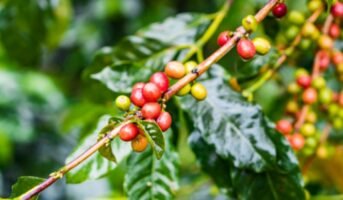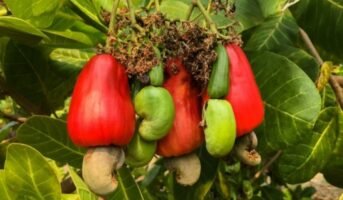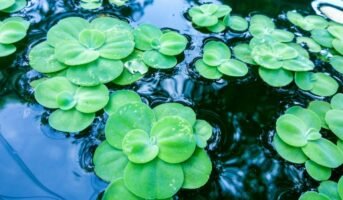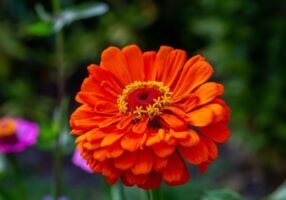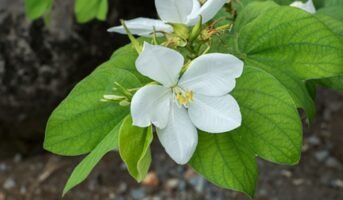A perennial herbaceous vine, Mikania Micrantha climbs and develops in various ways. It can be 3–6 metres long. The stems are thin, hexagonal, frequently heavily branched and interwoven, and yellow to brown. The leaves are simple, oblique, and with long-petioles. The leaf blade is widely ovate or triangular, has a sharp tip, a deeply cordate base, is attenuated, and is either nearly hairless on the underside or has sparse hairs. Four small heads that range in colour from white to greenish white are used to group the blooms. These inflorescences are borne by lengthy stalks that have numerous branches.

Source: Wikipedia
However, because it is adaptable to any décor, Mikania Micrantha is excellent for outdoor planting. Let’s explore the advantages, unique characteristics, and other information about Mikania Micrantha as we learn how to grow it in your backyard.
What is Mikania Micrantha?
Mikania Micrantha, often known as a bitter vine, climbing hempvine, or American rope, is a tropical plant in the Asteraceae family. Another name for it is mile-a-minute vine. Although it may adapt to less fertile soils, this perennial creeper grows most vigorously in regions with excellent soil fertility, light, and humidity levels. The wind spreads the feather-like seeds.
A single stalk of Mikania Micrantha can produce between 20 and 40 thousand seeds a season. It may reproduce vegetatively through its roots and make thousands of tiny, wind-dispersed seeds, which cause a swift and extensive invasion of this weed in any disturbed area.
Mikania Micrantha: Key facts
| Global description | The perennial climber Mikania Micrantha is native to tropical America. It has become a significant invasive in several regions of southeast Asia and the Pacific islands. Mikania Micrantha was first brought to India as ground cover in tea plantations in the 1940s, and it is now a severe danger to many plantation crops and forest regions all over the nation. |
| Cotyledons | Cotyledons are stalked, fleshy, hairless, and oval in shape with an attenuated base and notched tip. |
| First leaves | The first leaves are simple, opposite, glabrous, and carried by a long petiole. Blade subentire to approximately crenate or wavy, lanceolate oblong, elongated, attenuated at the top, and shortly acuminate. Three veins from the base mark the upper face. |
| General habit | A vine that encircles trees or crops |
| Underground system | Deep rooting of a taproot |
| Stem | Small, full, branching, and interlaced rods that are cylindrical or hexagonal, ranging in colour from yellow to brown. Young stems have minimal pubescence, which becomes glabrous as they age. |
| Leaf | Simple, opposite, stalked leaves. Oval or triangular, 3 to 13 cm long, 3 to 10 cm wide, and nearly glabrous or having a sparse pubescence on the lower face. Its base is a deep, roped substrate, and its apex is sharp. From the bottom, 3 to 7 palmate veins combine to produce the primary venation. Sub Entire, wavy, or rough-toothed margins. Small petiole that is roughly the same length as the blade. |
| Inflorescence | Small white or greenish-white flower heads placed in panicles and dense, terminal, and lateral composite cymes make up the inflorescence. Long-stalked flowers are in bloom. The flower stalk is 5 mm long and has a subinvolucrale bract about 2 mm long, narrowly elliptic to obovate, acuminate, glabrous to somewhat pubescent. Only 4 blossoms are present in the 4 to 5.5 mm long flowers. The two rows of involucral bracts are arranged. They have a laciniate edge, an acute or briefly acuminate apex, and an obovate, oblong shape. They are greenish white, sparsely hairy, and about 3.5 mm long. |
| Reproduction and dispersal | Mikania Micrantha can reproduce vegetatively through stem fragments that can quickly grow into new plants and reproductively through seeds. The seeds are typically carried by the wind or stick to people, pets, and clothing. In gardens, trash deposited during cultivation procedures, and during floods, stem fragments can be spread to other regions. |

Source: Pinterest
Mikania Micrantha flower
The flowers of Mikania Micrantha are all white, tubular, and have corollas that end in five triangular lobes that are 2.5 to 3 mm long. They are quite beautiful and can add to the beauty and vividness of any garden, which is why they are often used for beautification purposes.
Mikania Micrantha fruit
The fruit of Mikania Micrantha is oblong to obovate, ribbed, pentagonal-sectioned, black achene between 1.5 and 2 mm long. It has bristles covering its white longitudinal ribs. There are few glands on the faces of these fruits. The achene is topped by a pappus, which has bristles that are 2.5 mm long, white, barbed, and sometimes swollen at the top.
Mikania Micrantha: Biological and ecological description
Mikania Micrantha: Genetics
Mikania Micrantha communities in Brazil have little morphological diversity. However, chromosomal polymorphism is widespread. Eight of the 12 populations under investigation were diploid, while four were tetraploid.
Mikania Micrantha: Physiology and phenology
Some studies claim that 30 days after germination, Mikania Micrantha seedlings have a height of 1.1 cm and a leaf surface area of 0.3 cm2. If the temperature, light, and moisture are right, Mikania Micrantha will thrive all year round.
Various nations have different Mikania Micrantha growth rates. From flower bud to full bloom, flower to anthesis, and finally from mature seed production, Mikania Micrantha needs about five days. Flowers bloom during the dry season, and seeds are produced from November to February. Flowering has been observed in the Dongguan region from October to December, and fruits from November to December. Flowers typically can’t pollinate themselves and need insects or the wind to do so.
Mikania Micrantha: Reproductive biology and ecology
Mikania Micrantha reproduces sexually utilising seeds. The biomass of the flowers makes up 38.4–42.8% of the plant’s total biomass during the sexual reproduction period. The tiny size of the seeds makes them ideal for wind dissemination. About 40,000 seeds per Mikania Micrantha can be produced, and wind, water, and animals spread the seeds. Although temperature impacts the germination percentage, the ideal range is 25 to 30 degrees Celsius, with high seed germination rates. The fact that seeds from Mikania Micrantha germinate more readily in the spring than in the fall suggests that these seeds may require after-ripening. After manually or mechanically slashed, Mikania Micrantha can quickly shoot runners and suckers and regenerate from stem fragments.
In tropical regions, Mikania Micrantha is a species that is widely distributed. In cities and fields, it is so prevalent that fences, hedges, and occasionally even the ground are covered. In deserted locations, it creates broad, dense masses. Mikania Micrantha frequently occurs in meadows, crops, roadsides, riparian woods, and degraded forests. Wet, 0-2000 m altitude, sunny or shady surroundings. It grows better when the soil is fertile and the air is humid.
Mikania Micrantha: Environmental requirements
Mikania Micrantha can grow at an elevation of 2000 m or higher, giving it a broad altitudinal distribution. Mikania Micrantha may thrive in various soil conditions, including acidic, alkaline, infertile, and highly fertile soil. It has been claimed that it may succeed in multiple soil conditions, including rocky, gravelly, calcareous, sandy, loamy, and clay soils, with a pH range of 3.6 to 6.5. Mikania Micrantha thrives in climates with an average yearly temperature of more than 21°C and a soil moisture content of at least 15%. This plant can endure locations with free drainage, wet soil, and moist environments.
Mikania Micrantha: Climatic conditions for growth
| Climate | Status | Description |
| Tropical/Mega thermal climate | Preferred | Average lowest month temperature > 18°C and annual precipitation > 1500mm |
| Tropical rainforest climate | Preferred | Rainfall of more than 60 mm every month |
| Tropical monsoon climate | Preferred | Tropical monsoon climate (driest month with less than 60mm of precipitation, but greater than 100 – [total annual precipitation(mm)/25]) |
| Tropical savanna climate with dry summer | Tolerated | The driest month (in the summer) has 60 mm of precipitation, and (100 – [total annual precipitation mm/25]) |
| Tropical wet and dry savanna climate | Tolerated | The driest month (in winter) has 60 mm of precipitation, and (100 – [total annual precipitation mm/25]) |
| Temperate/Mesothermal climate | Preferred | Average temperature of the coldest and warmest months is between 0°C and 18°C, respectively. |
| Warm temperate climate, wet all year | Preferred | Warm average temperature > 10°C, Cold average temperature > 0°C, and rainy all-day |
| Warm temperate climate with dry summer | Tolerated | Dry summers with warm average temperatures > 10°C and cold average temperatures > 0°C |
| Warm temperate climate with dry winter | Preferred | Warm, temperate weather with dry winters (Warm, on average, > 10°C; Cold, on average, > 0°C) |
Mikania Micrantha: Characteristics
| Weed potential | Yes |
| Habit | Perennial Climber |
| Height | 0.00 m |
| Cultivation status | Ornamental, Wild |
Mikania Micrantha: Uses
Mikania Micrantha has been used as a ground cover because of how quickly it grows and covers the ground. However, due to the plant’s propensity to escape cultivation and invade its native habitat, this application should only be considered within its native area. A tea brewed from the entire Mikania Micrantha alleviates stomach aches and cleans the uterus. When combined with other plants, it is cooked to create a tonic that can lower malarial fever. Children’s clyster is treated with a decoction of the stem and leaves, which is also used to treat malaria and eczema. For colds, headaches, and stomachaches, the stems of Mikania Micrantha are squeezed, combined with ginger rhizomes, and eaten with green vegetables.
The leaves have febrifuge, cholagogue, antidote, and diuretic properties. They are boiled, and the water is then consumed to prevent menstruation. Snakebite and syphilis are treated with an infusion of Mikania Micrantha. External sores and itching are treated by topically applying the leaf juice. Children’s anal thrush is treated with leaves in a liquid mixture, and postpartum mothers are given hot water baths with leaves. A febrifuge bath uses a decoction. Smallpox, chicken pox, measles, rashes, and other skin eruptions can all be treated using an infusion to cleanse the skin. Bush yaws and persistent sores are treated with leaf juice from the macerated leaves. The macerated leaves of Mikania Micrantha are forcefully rubbed on the skin as a remedy for rashes.
Mikania Micrantha: Growth and development
Mikania Micrantha tolerates slight shade; grows best in high soil and air humidity, fertility, and organic matter conditions. According to many people, one of the worst weeds in the world is this species. It is a significant weed in pastures, plantations, and by the sides of roads. It is a moderate weed in agriculture and forestry. Mikania Micrantha can handle some shade and outgrows vacant spaces exceptionally quickly. As the ground is swiftly covered by a dense, tangled mat of trailing stems, the plant can quickly take over cleared areas, particularly those in or close to forests. It also tends to smother small trees and shrubs, which can often be almost invisible. The wind, clothing, or animal hair all play a part in dispersing the seed.
Additionally, Mikania Micrantha grows with the vegetative propagation from broken stem pieces, and each stem node can create roots. This species is also helped in its spread by using it as a cover crop, cow feed, and garden adornment. All year long, Mikania Micrantha can bear fruit and bloom.
Is Mikania Micrantha invasive?
Mikania Micrantha is considered a highly invasive species in many parts of the world. After being established, Mikania Micrantha spreads alarmingly, swiftly filling in cracks in disturbed areas and eventually harming or killing other plants by blocking their light or suffocating them. It is thought that in addition to competing with other plants for water and nutrients, it also releases chemicals that hinder other plants’ growth and obstruct the nitrification process. Due to massive logging and forest degradation, Mikania Micrantha has become more prevalent in many tropical regions. It begins by colonising the degraded forestland and then spreads to the nearby gardens, severely harming the agroforestry, home gardens, and plantation ecosystems in addition to the natural forest ecosystems. Therefore, decreased agriculture output, loss of biodiversity, and obstruction of forest regeneration are significant threats.
What does Mikania Micrantha do to pose a threat?
One of the top 100 harmful species in the world, Mikania Micrantha, can cause crop problems. Its capacity for vegetative reproduction necessitates the complete elimination of the plant to ensure effective control over its growth and spread. It mobilises nutrients from the soil and can prevent young plants from germination and healthy development—major weeds in pastures, plantations, and along roadsides; minor weeds in culture and woodland. Once established, Mikania Micrantha spreads quickly by climbing, twisting, and burying itself in vegetation. Its stems have a daily growth rate of 27 mm. Using its cover to block out light, Mikania Micrantha can cause the supporting plants to fall. Nurseries and young plants are particularly at risk. It engages in competition with other species for water and nutrients and also seems to be allelopathic to them.
Because of its propensity to quickly climb on plants, Mikania Micrantha is a massive issue for sugarcane, fruit, and food crops. It can result in a significant yield reduction when it fully covers them. Mikania Micrantha can prevent young plants from growing well and hinder seedling germination because it mobilises nutrients from the soil. It is less of an issue in vegetable crops since regular weeding and ploughing procedures significantly restrict their growth.

Source: Wikimedia
Mikania Micrantha: Controlling the growth
The complete removal of Mikania Micrantha from production plots and their export, chemical management with selective herbicides when they are present in other cultures, and systemic herbicides continue to be the two most successful methods of preventing Mikania Micrantha.
Mikania Micrantha: Physical control
Since the seeds are widely dispersed, and the vines readily root when they touch damp soil, physical control is difficult. In areas with a drier or cooler season, repeated cutting or mowing, done before the plant flowers and during periods of diminished development, can help curb the spread of Mikania Micrantha but will not completely eradicate it.
Mikania Micrantha: Chemical control
Currently, herbicides appear to be the only effective way of control. However, applying herbicides in large quantities to forested areas, for instance, is not always practicable and may harm the ecology. The leaves and flowers of the flame tree demonstrated significant phytotoxicity when the allelopathic capability of other plants against Mikania Micrantha seedlings was assessed. Allelochemicals may therefore be used to control Mikania Micrantha as a natural herbicide.
Mikania Micrantha: Biological control
Several natural adversaries of Mikania Micrantha show a lot of promise. Liothrips Mikaniae, a thrips, Teleonemia sp., a bug, various beetles, and an eriophyid mite, Acalitus sp., have all demonstrated some plant-specificity and may have great potential as biological control agents. In India, fungi pathogens have also been researched as potential biological control agents. The Central and South American rust Puccinia spegazzinii, which has shown to be completely specific against the plant, may end up being the “silver bullet” among those. Rust causes cankering of the stem, petiole, and leaves, ultimately killing the entire Mikania Micrantha.
Is Mikania Micrantha poisonous?
While there is no evidence of Mikania Micrantha being poisonous to either animals or humans, the plant is considered one of the most invasive plant species in the world and can be quite harmful for the other plants nearby as well as the environment. It is inadvisable to grow it anywhere other than its native habitats.
See also: About quarantine
Mikania Micrantha is a highly tenacious climber with thin, heavily branched; twining rarely stems more significant than 2 cm in diameter. The herb is collected from the wild for usage as a local medication. Additionally, it is grown as a ground cover and ornamental plant. However, its use should be avoided outside the plant’s natural habitat due to its propensity to spread like a weed.
FAQs
What are the health benefits of Mikania Micrantha?
Mikania Micrantha is known to possess anti-inflammatory, analgesic, and antimicrobial properties and used to treat asthma, fever, cough, and arthritis.
Can you grow Mikania Micrantha at home?
Mikania Micrantha can be grown at home, but it requires specific growing conditions. Mikania Micrantha thrives in warm, humid environments and needs well-drained soil. You can propagate it by stem cuttings or by sowing seeds.
Is Mikania Micrantha invasive?
Yes, Mikania Micrantha is considered an invasive species in many regions around the world. It can grow and spread rapidly, eating away the native plant species and disrupting ecosystems. Thus its i growth and spread has to be controlled.
What are some of Mikania Micrantha's common names?
American rope, bitter vine, Chinese creeper, mikania, mikania vine, mile a minute, mile a minute weed, mile a minute, mile a minute weed, climbing hempvine, climbing hempvine, and climbing hempweed are some of the common names of Mikania Micrantha.
Is Mikania micrantha a herb?
Mikania Micrantha, often known as the bitter vine, climbing hempvine, or American rope, is a tropical plant in the Asteraceae family.
How are Micrantha Mikania's powers maintained?
Controlled fire will kill 73.8% of Mikania micrantha. In a manual cutting block, it can also be decreased by 34.9%. Mikania Micrantha had lower coverage than the control block in controlled fire and manual cutting by 58% and 18.8%, respectively.
Does Micrantha Mikania resemble any other species?
When not in bloom, the Mikania vine resembles various vines, such as the climbing and ivy groundsels. Although only often found in sub-tropical and temperate climates, each plant has yellow flowers.
What are Micrantha Mikania's effects on the environment?
Northern Queensland and other parts of northern Australia are home to Mikania Micrantha, a potentially harmful weed for the environment. It is on the Northern Australia Quarantine Strategy list and has recently been designated as a priority environmental weed in at least one Natural Resource Management region. Mikania micrantha is among the top 100 most invasive alien species in the world and is classified in the Global Invasive Species Database due to its global invasiveness.
Housing News Desk is the news desk of leading online real estate portal, Housing.com. Housing News Desk focuses on a variety of topics such as real estate laws, taxes, current news, property trends, home loans, rentals, décor, green homes, home improvement, etc. The main objective of the news desk, is to cover the real estate sector from the perspective of providing information that is useful to the end-user.
Facebook: https://www.facebook.com/housing.com/
Twitter: https://twitter.com/Housing
Email: [email protected]

